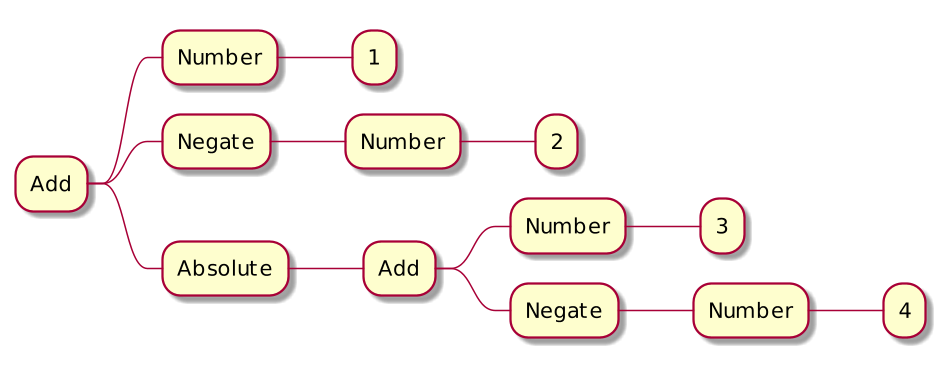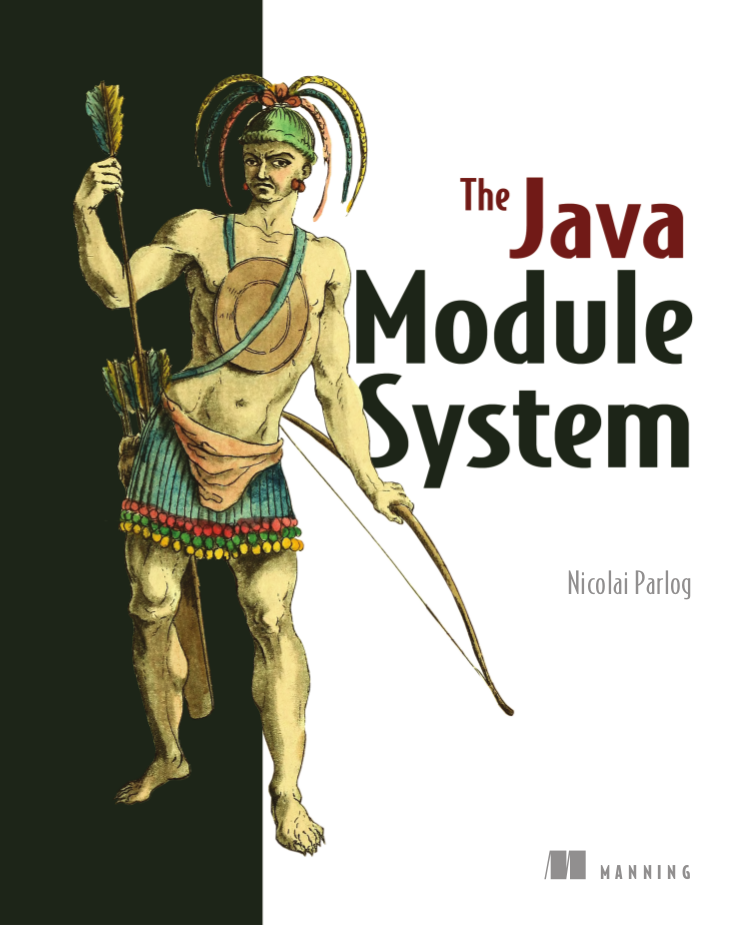interface Node { }
record Number(long number) implements Node { }
record Negate(Node node) implements Node { }
record Absolute(Node node) implements Node { }
record Add(List<Node> summands) implements Node {
Add(Node... summands) {
this(List.of(summands));
}
}Pattern Matching in Java (17)
Salvation
Salvation by Peter F. Hamilton
The Back Story
We want to evaluate simple arithemtic computations,
for example:
1 + (-2) + |3 + (-4)|
Add(1, (-2), |3 + (-4)|)
Add(1, Negate(2), |3 + (-4)|)
Add(1, Negate(2), Absolute(3 + (-4)))
Add(1, Negate(2), Absolute(Add(3, (-4))))
Add(1, Negate(2), Absolute(Add(3, Negate(4))))
The Back Story
1 + (-2) + |3 + (-4)|
Add(1, Negate(2), Absolute(Add(3, Negate(4))))

The Main Characters
The Main Characters

new Add(
new Number(1),
new Negate(new Number(2)),
new Absolute(new Add(
new Number(3),
new Negate(new Number(4)))));The Complication
Given a
Node, evaluate the computation.
Easy:
interface Node { long evaluate(); }
record Number(long number) implements Node {
public long evalute() { return number; }
}
record Negate(Node node) implements Node {
public long evalute() { return -node.evalute(); }
}The Crisis
If you change
Node, we annihilate Earth!
We need to evaluate "from the outside":
static long evaluate(Node node) {
// ...
}The Plot Thickens
Evaluate Node without changing the interface.
Flashback
interface Node { }
record Number(long number) implements Node { }
record Negate(Node node) implements Node { }
record Absolute(Node node) implements Node { }
record Add(List<Node> summands) implements Node { }Type Checking and Casting
static long evaluate(Node node) {
if (node instanceof Number)
return ((Number) node).number();
if (node instanceof Negate)
return -evaluate(((Negate) node).node());
if (node instanceof Absolute) {
long r = evaluate(((Absolute) node).node());
return r >= 0 ? r : -r;
}
if (node instanceof Add)
return ((Add) node)
.summands().stream()
.mapToLong(Nodes::evaluate)
.sum();
throw new IllegalStateException();
}Type Checking and Casting
Showdown:
hard to write and read
casting is error-prone
new/forgotten
Nodeimplementations
lead to run-time errors
Type Patterns
A pattern is:
a test/predicate that is applied to a target
pattern variables that are extracted from
the target if the test passes
This is a type pattern:
// |---- pattern -----|
//target |---- test -----| variable
if (node instanceof Number no)
// ... use `Number no`(Type pattern were finalized in Java 16.
We will see more patterns in the future.)
Type Patterns
static long evaluate(Node node) {
if (node instanceof Number no)
return no.number();
if (node instanceof Negate neg)
return -evaluate(neg.node());
if (node instanceof Absolute abs) {
long result = evaluate(abs.node());
return result >= 0 ? result : -result;
}
if (node instanceof Add add)
return add
.summands().stream()
.mapToLong(Nodes::evaluate)
.sum();
throw new IllegalStateException();
}Type Patterns
Better:
makes writing and reading easier
removes error-prone casting
Pattern Matching in Switch
Allows us to also use patterns in switch:
// makes `node` the target
switch (node) {
// |- test --| variable
case Number no -> // ... use `Number no`
// other cases
}(This is a preview feature in Java 17.)
Pattern Matching in Switch
static long evaluate(Node node) {
return switch (node) {
case Number no -> no.number();
case Negate neg -> -evaluate(neg.node());
case Absolute abs -> {
long result = evaluate(abs.node());
yield result >= 0 ? result : -result;
}
case Add add -> add
.summands().stream()
.mapToLong(Nodes::evaluate)
.sum();
default ->
throw new IllegalArgumentException();
};
}Pattern Matching in Switch
Better:
makes writing and reading even easier
Deconstruction Patterns
Allows us to deconstruct records
into their components:
// flashback
record Number(long number) implements Node { }
if (node instanceof Number(long no))
// ... use `long no`
switch (node) {
case Number(long no) -> // ... use `long no`
// other cases
}(Candidate for preview in Java 18.)
Deconstruction Patterns
static long evaluate(Node node) {
return switch (node) {
case Number(long no) -> no;
case Negate(var n) -> -evaluate(n);
case Absolute(var n) {
long result = evaluate(n);
yield result >= 0 ? result : -result;
};
case Add(var summands) -> summands.stream()
.mapToLong(Nodes::evaluate)
.sum();
default ->
throw new IllegalArgumentException();
};
}Deconstruction Patterns
Better:
reduces number of variables/calls
Guarded Patterns
Allows us to add boolean checks to patterns:
Node node = // ...
switch (node) {
case Number(long no && no > 0) ->
// ... use `long no`, which is positive
case Number(long no && no < 0) ->
// ... use `long no`, which is negative
case Number(long __) ->
// we know the number is 0
// other cases
}(This is a preview feature in Java 17.)
Guarded Patterns
static long evaluate(Node node) {
return switch (node) {
case Number(long no) -> no;
case Negate(var n) -> -evaluate(n);
case Absolute(var n) && evaluate(n) < 0 ->
-evaluate(n);
case Absolute(var n) -> evaluate(n);
case Add(var summands) -> summands.stream()
.mapToLong(Nodes::evaluate)
.sum();
default ->
throw new IllegalArgumentException();
};
}Guarded Patterns
Better:
elevates checks into
case
Sealed Classes
Controls inheritance and
makes inheriting types known:
// 👾👾👾: 🤨
sealed interface Node
permits Number, Negate, Absolute, Add { }
// ⇝ no other type can implement `Node`(Sealed classes were finalized in Java 17.)
Sealed Classes
static long evaluate(Node node) {
return switch (node) {
case Number(long no) -> no;
case Negate(var n) -> -evaluate(n);
case Absolute(var n) && evaluate(n) < 0
-> -evaluate(n);
case Absolute(var n) -> evaluate(n);
case Add(var summands) -> summands.stream()
.mapToLong(Nodes::evaluate)
.sum();
// no default branch needed
};
}Sealed Classes
Better:
turns new/forgotten
Nodeimplementations
into compile errors
Timeline
- Java 16
type patterns
- Java 17
sealed classes
patterns in
switch(preview)guarded patterns (preview)
- Java ??
deconstruction patterns
(candidate for preview in 18)
Plot Holes
pattern variable scope
dominance of pattern labels
completeness of pattern labels
nullhandling inswitchrules for sealed types
deconstruction of arrays
Happy End
if-else chains over types and conditions are:
hard to write and read
error-prone due to casting
hard to maintain when type hierarchy expands
Compare to pattern matching:
easy to write and read (after getting used to them)
safe casting and easy deconstructing out of the box
sealed types allow use-site opt-in compiler
support for expanding type hierarchy
Resolution
When should you use this?
Domain Overload
Should you add evaluate this way?
Probably not.
But what about:
Resources estimateResourceUsage()Strategy createComputationStrategy()Invoice createInvoice(User u)String prettyPrint()(like here)void draw(Direction d, Style s, Canvas c)
⇝ Central abstractions can be overburdened
with diverse requirements.
Visitor Pattern
Separating a hierarchy from operations
is a case for the visitor pattern.
👾👾👾
Using pattern matching over sealed type:
will often achieve same results
leads to much simpler code
Edge of Space
When parsing outside data,
types are often general
(think JsonNode).
Consider pattern matching
to tease apart the data.
Conclusion
polymorphism remains default approach
to adding operations to typeswhere that’s not ideal or where types are general
consider pattern matching (and sealed classes)together, they make it easy and safe
to branch based on type and other properties
Sequels
So long…
More
Slides at slides.nipafx.dev⇜ Get my book!
Follow Nicolai
nipafx.dev/nipafx
Follow Java
inside.java/java // /openjdk
Image Credits
starship: cover of Salvation by Peter F. Hamilton; Macmillan
arithmetic tree: Nicolai Parlog, CC-BY-NC 4.0



